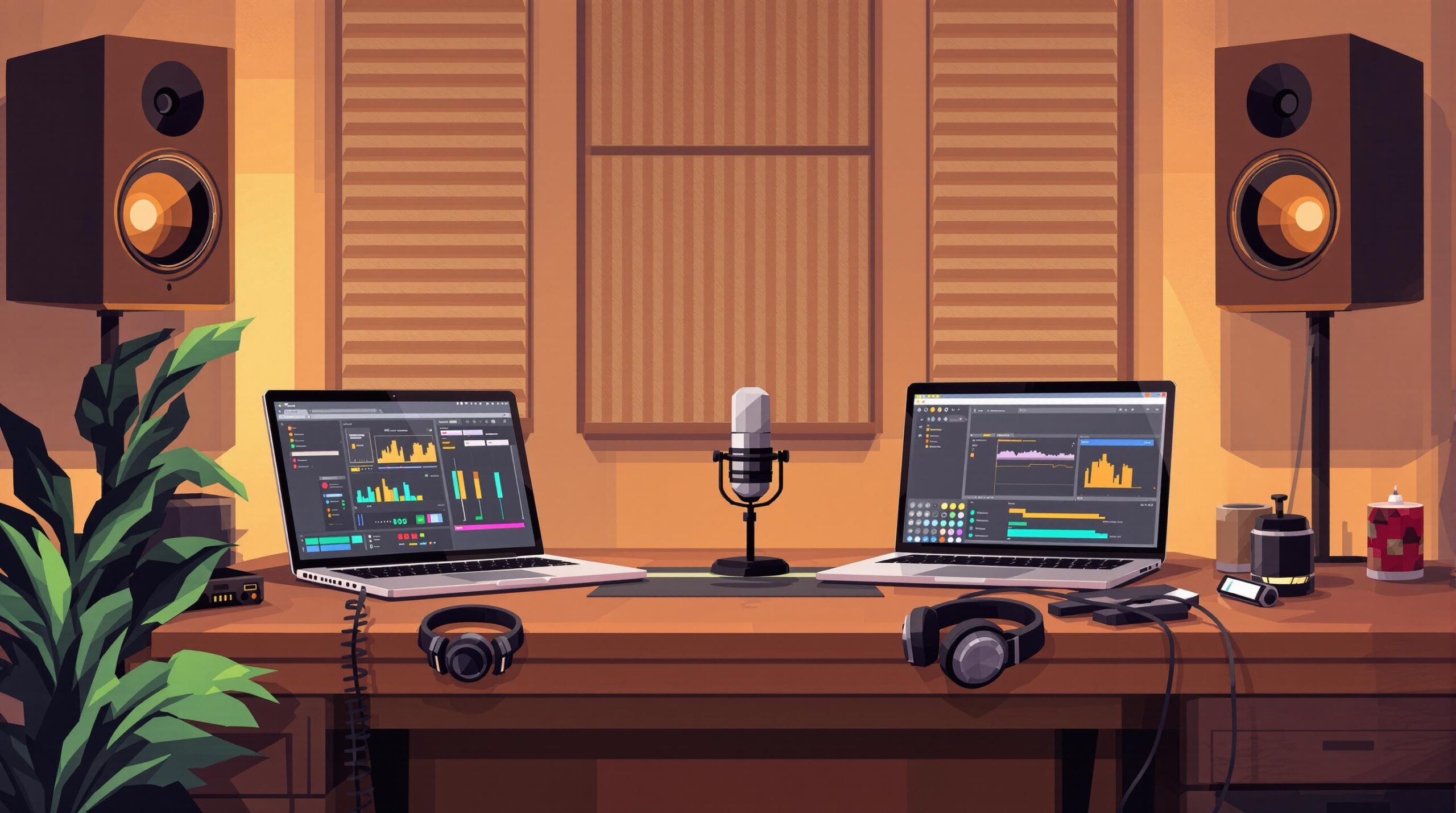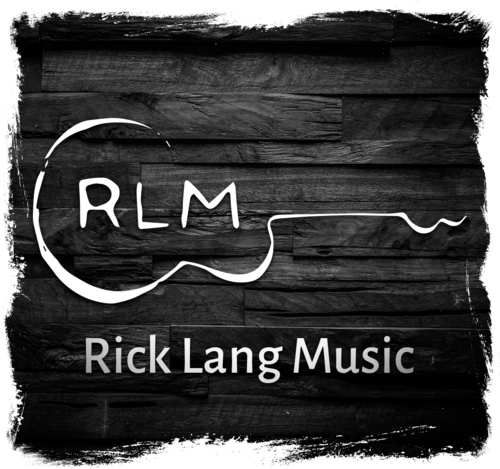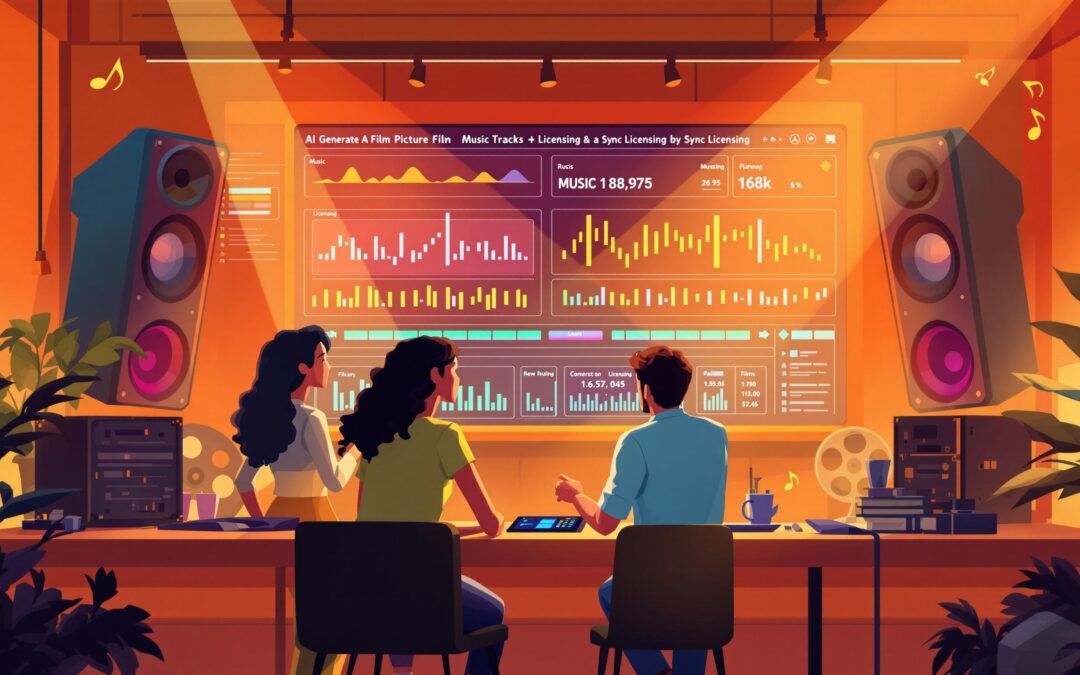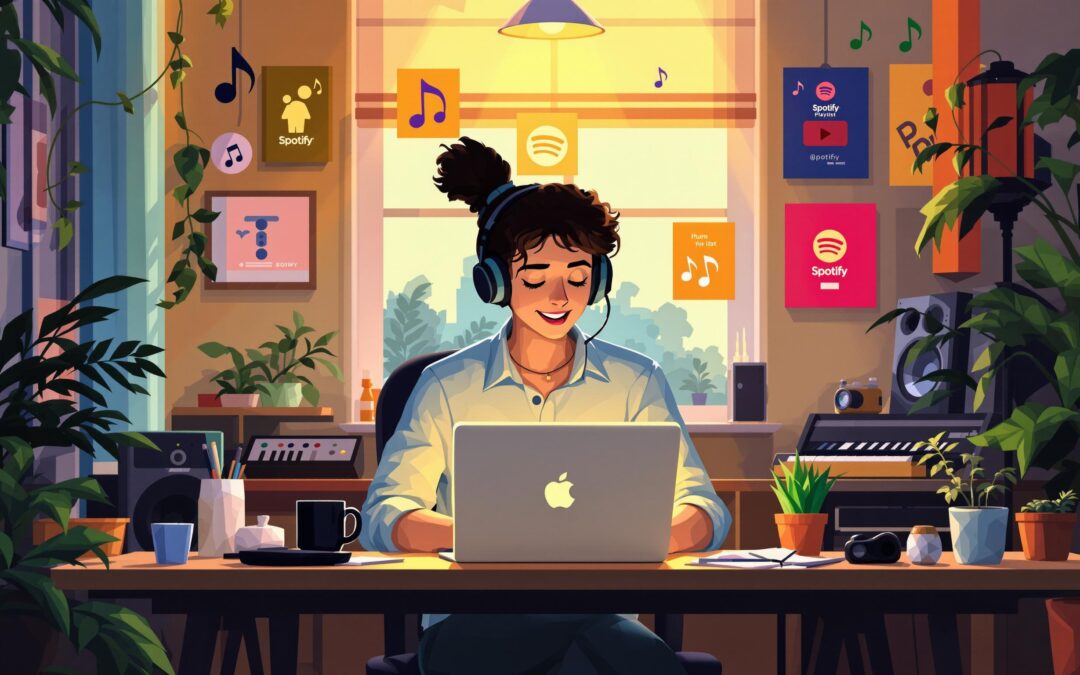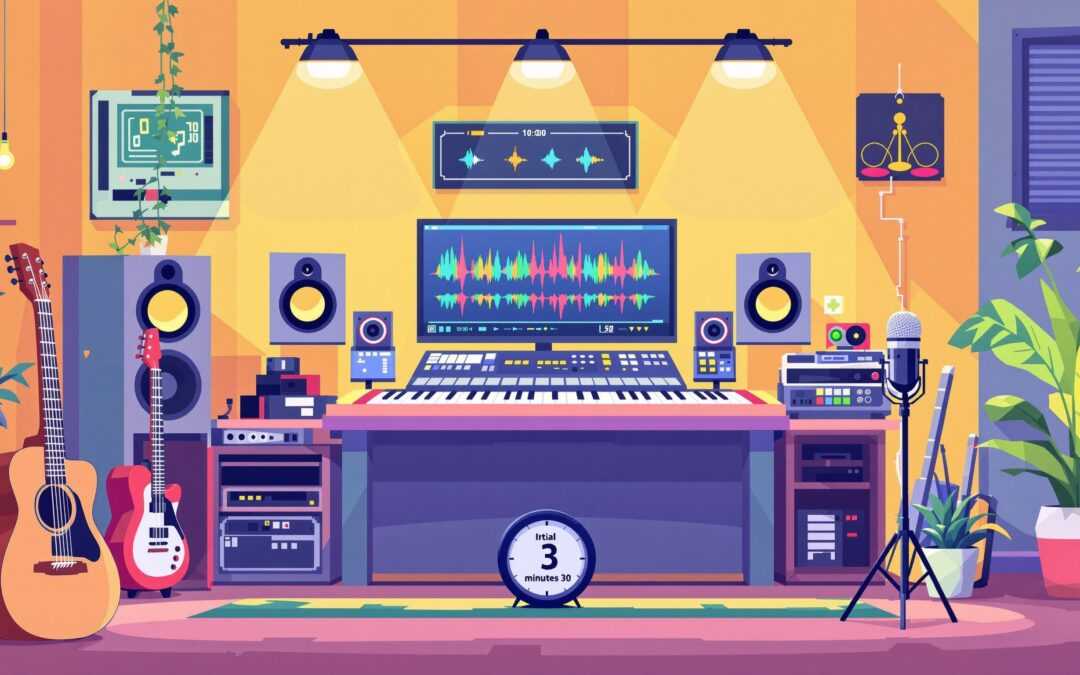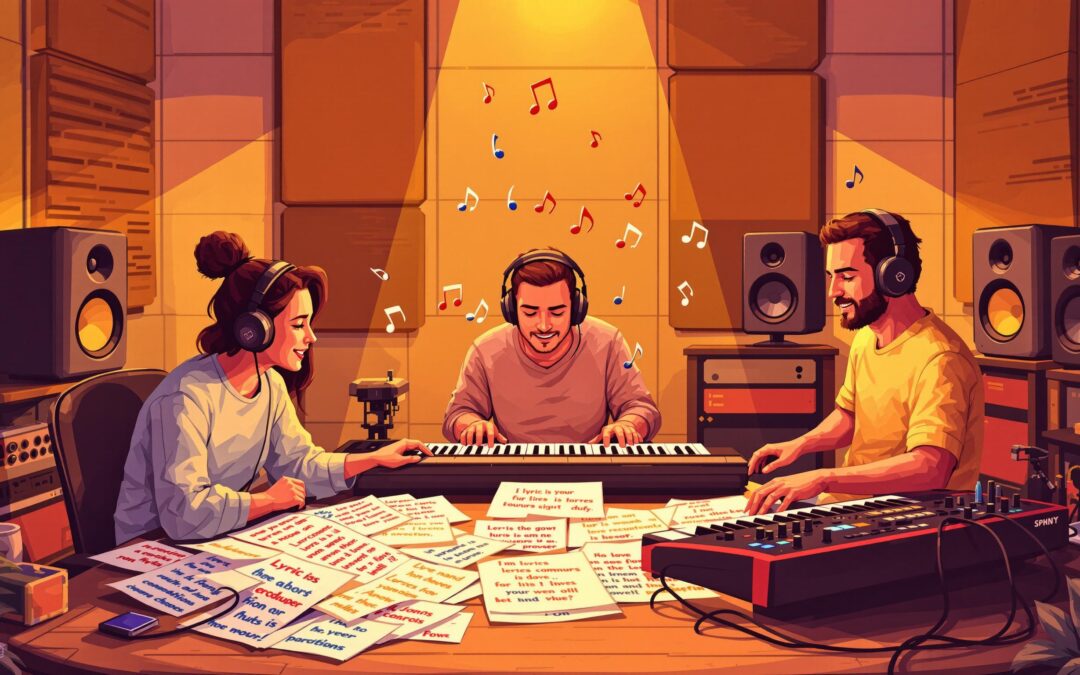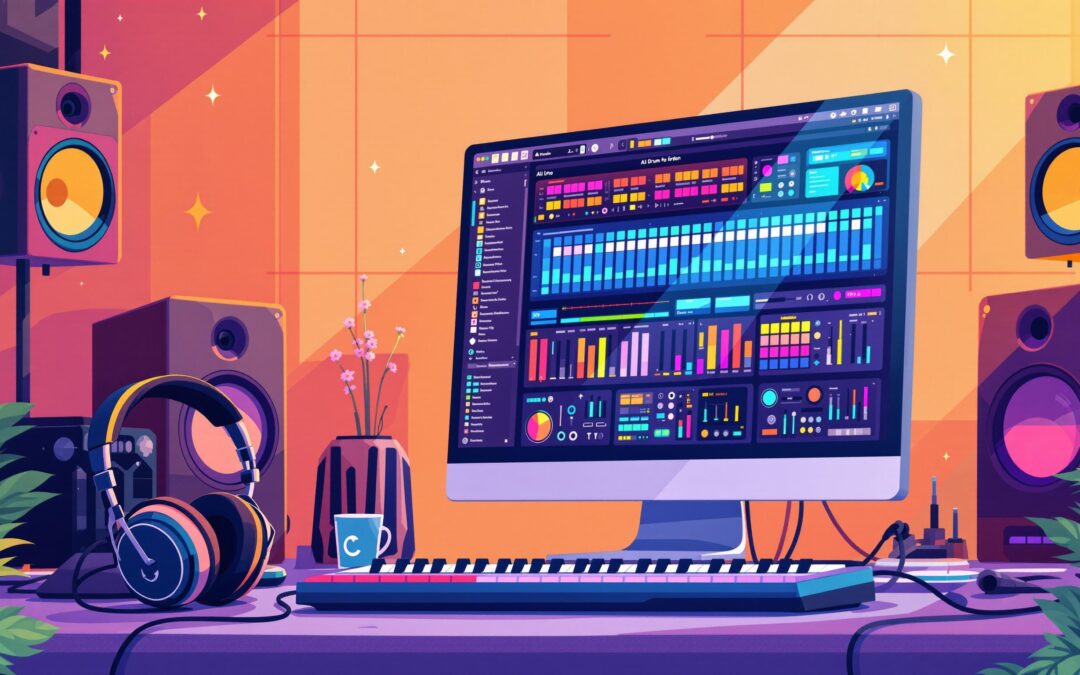Setting up a home studio doesn’t have to be complicated or expensive. Here’s what you need to get started:
-
Core Equipment:
- Computer: At least 8GB RAM (16GB recommended) and a 256GB SSD for smooth performance.
- DAW (Digital Audio Workstation): Options include free tools like Cakewalk or budget-friendly Reaper ($60).
- Audio Interface: Focusrite Scarlett 2i2 ($160) or Behringer UMC22 ($50) for beginners.
- Microphones: Condenser for vocals, dynamic for louder instruments, and ribbon for warm tones.
- Headphones: Closed-back for recording, open-back for mixing.
- Monitors: PreSonus Eris E3.5 ($99 per pair) for accurate sound.
-
Room Setup:
- Add acoustic foam panels, bass traps, and rugs to improve sound quality.
- Position studio monitors in an equilateral triangle with tweeters at ear level.
- Budget: Start with $300–$500 for a basic setup. Upgrade gradually as needed.
Quick Tip: Spend on a good microphone first – it makes the biggest difference in sound quality.
Beginner Home Studio Setup (3 Different Budgets)
Core Studio Equipment List
Set up your home studio with the right tools for professional-quality recordings.
Computer and DAW Selection
A reliable computer is the backbone of your studio. Opt for one with at least a quad-core CPU (2.5 GHz or higher), 16 GB of RAM (32 GB if you’re handling larger projects), and a 500 GB SSD for smooth performance .
When it comes to choosing a DAW (Digital Audio Workstation), it’s all about what suits your workflow. Here’s a quick comparison of popular options:
| DAW | Price | Best For | Key Features |
|---|---|---|---|
| Logic Pro | $199.99 | Professional Production | Packed with virtual instruments and effects |
| Reaper | $60 | Budget-conscious Users | Streamlined workflow with essential tools |
| Pro Tools | Subscription | Commercial Studios | Industry standard with hardware integration |
| GarageBand | Free | Beginners | Easy-to-use interface, perfect for starters |
Once your DAW is set, the next step is to ensure high-quality audio with a dependable audio interface.
Audio Interfaces
An audio interface is crucial for capturing sound accurately. For entry-level users, the SSL 2+ ($279) is a solid choice . When selecting an interface, pay attention to:
- Input/output options
- Connection type (e.g., USB, Thunderbolt)
- Preamp quality
- Extra features like built-in MIDI support
Pair your interface with the right microphones for your recording needs.
Microphones and Must-Have Accessories
Different microphones serve different purposes. Here’s a quick breakdown:
- Condenser Microphones: Great for vocals and acoustic instruments due to their sensitivity and wide frequency range.
- Dynamic Microphones: Durable and ideal for louder sources like drums and guitar amps.
- Ribbon Microphones: Provide a softer, warm tone that works well for specific genres .
Don’t forget essential accessories like:
- Pop filters
- Microphone stands
- XLR cables
- Shock mounts
These tools ensure clean and professional recordings.
Monitors and Headphones
Accurate sound reproduction is key. Choose monitors with a flat, neutral response. For headphones, look for:
- Flat frequency response for precise monitoring
- Comfortable design for long sessions
- Closed-back models for recording
- Open-back models for mixing
Both monitors and headphones are vital for fine-tuning your sound.
Room Treatment
Control unwanted reflections and bass buildup with simple room treatment solutions. Use acoustic foam panels, bass traps, heavy curtains, and rugs to create a balanced listening environment.
sbb-itb-1c6af30
Studio Setup Guide
Room Layout and Placement
Getting your studio layout right starts with proper monitor placement. Arrange your studio monitors and your listening spot to form an equilateral triangle, with monitors angled inward at about 30 degrees . Keep the monitors 20–90 cm away from the walls to reduce unwanted sound reflections.
"Positioning monitors correctly in your music making space is essential to ensuring an accurate listening experience." – HEDD Audio
Here are some tips for accurate sound reproduction:
- Tweeters at ear level: This ensures clarity in high frequencies.
- Desk along the longer wall: Reduces side reflections for a cleaner sound.
- Varied distances from walls: Avoids sound buildup by keeping monitors at different distances from side and back walls.
- Use stands or isolation pads: Minimizes vibrations that can muddy your audio.
- Subwoofers off-center: Place them off-center along the front wall to avoid bass buildup.
Don’t forget about ergonomics. Keep your most-used gear within arm’s reach, and consider wall-mounted shelves or racks to free up desk space. Once your room is set up, you’re ready to connect and fine-tune your equipment.
Equipment Setup and Testing
Set up and test your equipment step by step, following this signal flow:
1. Power Management
Plug everything into the same power strip or outlet to prevent ground loop issues. This simple step can save you from dealing with that annoying "Hmmm" noise common in home studios.
2. Audio Interface Configuration
Connect your audio interface to your computer, then hook up your monitors and other peripherals.
| Connection Type | Connection Order | Common Issues |
|---|---|---|
| USB/Thunderbolt | First connection | Driver installation |
| Monitor Outputs | Secondary connection | Volume calibration |
| Microphone Inputs | Final connection | Phantom power check |
3. Monitor Calibration
Use your DAW’s tools or the built-in DSP controls on your monitors to calibrate them .
When troubleshooting:
- Start at the source and work step-by-step through the chain.
- Test and, if needed, swap cables to fix quality issues.
- Check for phantom power if using condenser microphones.
- Monitor gain levels to avoid distortion or signal loss.
As you spend more time in your studio, you’ll naturally find ways to refine both the layout and the gear setup to better suit your workflow and improve efficiency.
Getting More from Your Studio
Future Upgrades
Once you’ve set up your core studio, it’s time to refine it with upgrades that tackle specific production needs. Start by focusing on the areas that have the biggest impact on your sound. Here’s a priority guide to help you decide:
| Priority Level | Upgrade Type | What It Improves |
|---|---|---|
| High | Source Equipment | Higher-quality instruments and proper upkeep |
| Medium-High | Recording Chain | Better microphones and preamps |
| Medium | Room Treatment | Acoustic panels and bass traps |
| Low | Software/Plugins | Access to new tools and effects |
For microphones, choose one that suits your specific recording requirements. For example, dynamic microphones like the Shure SM57 (around $100) are great for louder sound sources, while condenser microphones are ideal for capturing vocals and acoustic instruments .
In addition to upgrading your hardware, consider digital tools to further improve your production.
Online Tools and Resources
Online platforms can add new dimensions to your studio’s capabilities. Here are two standout options:
- Soundtrap: Offers over 24,000 loops in genres like Phonk, Drill, and Lo-Fi. It also includes built-in vocal tuning and automation tools, with regular updates introducing new sound packs every two weeks .
- BandLab: A free, all-in-one solution featuring unlimited multi-track recording, cloud storage for backing up projects, and a massive library of royalty-free samples .
When choosing a DAW (Digital Audio Workstation), it’s important to pick one that complements your workflow. Here’s a quick comparison:
| DAW | Price | Best For |
|---|---|---|
| Reaper | $60 | Producers on a budget |
| Logic Pro X | $200–500 | Mac users and general production |
| Ableton Live | $200–500 | Electronic music production |
| Pro Tools | $500/year | Professional audio recording |
Conclusion
Your home studio’s success depends on careful planning and smart choices. You don’t need high-end, pricey equipment to create quality recordings.
Pay attention to key factors like sound source quality, room acoustics, and accurate monitoring. Essential gear like the Scarlett 2i2 ($349) and Audio Technica ATH-M20X ($50) can get you started without breaking the bank .
Controlling your environment is also crucial – maintain a relative humidity of 50% and ensure proper ventilation to protect your equipment .
Most importantly, don’t overlook room acoustics. Effective monitoring begins with improving your listening space. As LEWITT’s content team points out:
"In fact, treating your listening environment is even more important than upgrading your studio monitors, as even mediocre monitors are usable if you can hear them well enough to mix around their flaws" .
